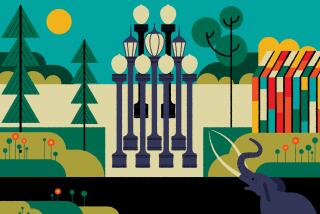Unusual Butterfly Show Is Sending Visitors’ Hearts Aflutter
- Share via
NEW YORK — The brown butterfly seemed to like its resting place--on Gabe Heafitz’s shirt. It crawled from one shoulder to the other and back, opening and closing its wings.
As for Heafitz, he just stood calmly and let it wander, not even flinching as it approached his neck. After all, this butterfly--and its home, an oasis of quiet and calm in the sometimes still-frantic city--were the reasons he came to the American Museum of Natural History.
“They just give you a peaceful feeling,” said Heafitz, who acknowledged that he didn’t really like other insects all that much. “They sort of flutter around; they don’t bother you.”
There are a lot of butterflies fluttering around at the museum, in a warm, humid preserve filled with the tropical plants these insects love, just down the hall from the giant dinosaur skeleton at the Central Park West entrance to the museum.
“The Butterfly Conservatory: Tropical Butterflies Alive in Winter” opened at the museum last month and runs through May. For the fourth year in a row, visitors can enter the space and see hundreds of the colorful, winged insects from all over the world.
Has to Be Seen to Be Believed
“They’re just absolutely gorgeous,” said Patricia Grillo, an assistant with the exhibit. “People come in here just in awe.”
It’s quite a setup: The “vivarium,” similar in shape to an indoor tennis court, is about 60 feet long by 21 feet wide by 10 feet high. The air is maintained at a moist 80 degrees, and halide lamps hang from the ceiling, simulating the light found in rain forests. There are plants and trees everywhere, providing perches as a place for the butterflies to rest as well as food sources.
As for the insects, the museum has them shipped in from butterfly farms all over the world: Africa, Asia, South America, as well as Florida and Texas. Because the life span of butterflies is short, only a couple weeks, hundreds are brought to the museum every week.
There are huge Atlas moths from Asia, which have no mouths once they emerge from their cocoons and live for about a week on the fat they ingested in their larval stage. Then there are the distinctive orange and black Monarchs, the butterflies that migrate by the millions from Canada and the United States to Mexico.
There are Owls and Paper Kites, Blue Morphos and even a butterfly called the Question Mark. Along one wall, there’s a case of pupae waiting to be hatched.
Creating a Comfy Home for Butterflies
The museum decided to start the exhibit in 1998, after observing similar conservatories in other facilities, said David Harbey, vice president for show. He said it takes about four to six weeks to put the exhibit up every year and to create the insects’ home.
Besides being a home for butterflies, the exhibit also has created a spot full of warmth and light during the cold winter season. The heat and humidity were a far step from the scene outside the museum on the city’s Upper West Side. Inside, there was peace and quiet, but outside, people wearing coats and gloves hurried through the gray, windy afternoon as cars and buses hurtled past.
That’s another reason Heafitz, 25, a former New Yorker who now lives in Alameda, Calif., liked it so much when the butterfly made itself at home on his shoulder.
“There’s just something about this exhibit,” he said. “It’s a respite from the hustle and bustle of the streets outside.”
More to Read
Sign up for The Wild
We’ll help you find the best places to hike, bike and run, as well as the perfect silent spots for meditation and yoga.
You may occasionally receive promotional content from the Los Angeles Times.






